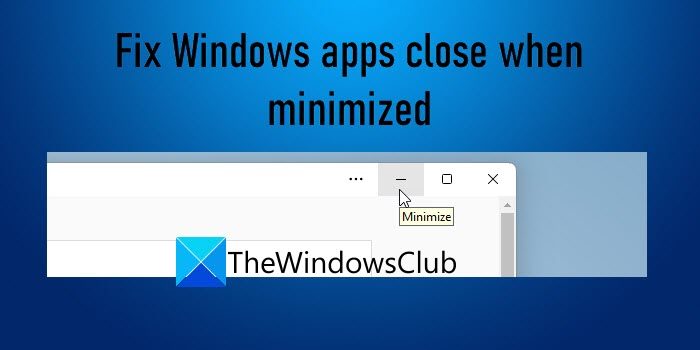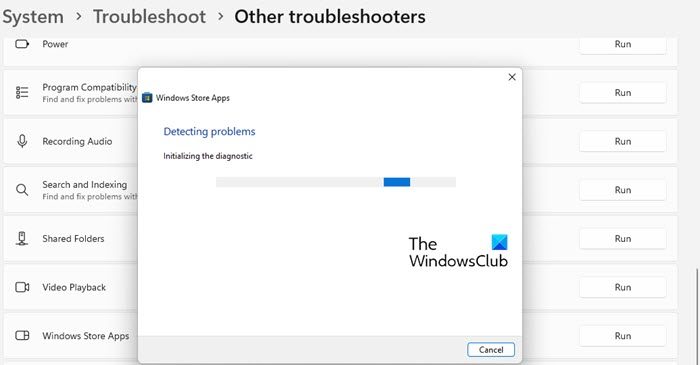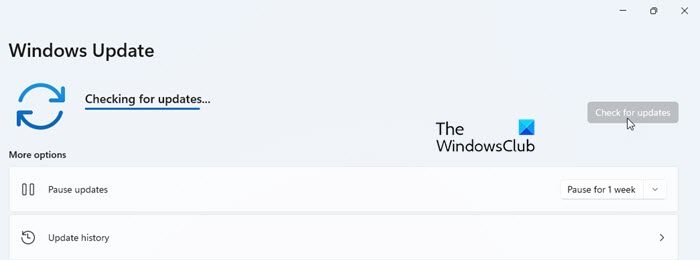If your Windows Apps close when minimized, then this post will help you. While working with multiple apps, we often minimize a few of them to keep them out of sight but running in the background. The minimize action (pressing on -) hides the app’s window from the desktop without exiting the app. When we minimize an app, its icon remains in the taskbar area, which we can click to restore the app to its previous size and location on the desktop, and bring it back into view.

What if the app closes abruptly instead of being minimized to the taskbar? It can be annoying to see the app closing while you’re in the middle of something important. In this post, we will look at the possible causes behind this error and try to resolve it using some effective solutions.
Windows Apps close when minimized in Windows 11/10
If Windows Apps close when you click on the ‘-‘ button to minimize them, follow these suggestions to resolve the issue:
- Run Windows Store Apps troubleshooter
- Run SFC or DISM scan
- Check background app permissions
- Update your OS or Uninstall recent Windows Update
- Use System Restore
- Use Reset This PC.
Let us have a look at these in detail.
1] Run Windows Store Apps troubleshooter

Start by running Windows Store Apps troubleshooter. It will diagnose and troubleshoot problematic apps by automatically applying some quick fixes.
- Click on the Start button in the Windows taskbar and select Settings.
- Navigate to the Troubleshoot option under System settings and click on it.
- Click on the Other troubleshooters option.
- Scroll down to the Windows Store Apps option.
- Click on the Run button next to the Windows Store Apps option.
- Allow the troubleshooter to detect problems on your Windows 11/10 PC.
- If the troubleshooter detects any problem, it will try to fix it automatically.
Related: Application stays minimized in the Taskbar
2] Run SFC or DISM scan

SCF and DISM are Windows built-in diagnostic tools. SFC scans Windows for corrupted or modified system files and replaces them with the correct version. DISM checks for corrupted files in the Windows component store and fixes the corruption using a Windows update.
Open an elevated command prompt and run an SFC scan using the following command:
sfc /scannow
If SFC is not able to detect or repair corrupt files, perform a DISM scan using the following command:
DISM.exe /Online /Cleanup-image /Scanhealth
The above command will check your system for component store corruption. If a corrupt file is found, use the following command to fix the issue:
DISM.exe /Online /Cleanup-image /Restorehealth
3] Check background app permissions

If the problem is with a specific app, check the background permissions of the app. Turning on the background app permissions may sometimes resolve the issue.
- Click on the Start button icon.
- Select Settings.
- Click on Apps on the left panel.
- Click on Installed Apps on the right panel.
- Click on the menu icon (three horizontal dots) next to the app’s name.
- Select Advanced options.
- Change the dropdown setting for Let this app run in the background to Always under Background apps permission.
If this doesn’t work, Reset the app to bring it back to its default state. This will fix issues with the non-working app.
4] Update your OS or Uninstall recent Windows Update

Check if an update is available for your Windows OS and install that update. An update will install bug fixes and security patches to resolve functionality issues with your OS and Windows Store apps.
- Press the Windows logo icon on your keyboard to launch the Start menu.
- Click on Settings.
- Click on Windows Update at the bottom of the left panel.
- Click on Check for updates button in the top-right corner.
- Wait for a few seconds till Windows checks for updates.
- Click on Download and install button to install the update.
- Restart your system and see if the problem is fixed.
If the issue started occurring after a recent update, you may want to consider uninstalling the Windows Update and see if that helps you.
5] Use System Restore
Restore your computer to a good point and see if that helps.
6] Use Reset This PC
If none of the above solutions work, reset Windows 11/10 to default and see if that helps.
Read Next: Full-screen Games minimizing to Desktop randomly in Windows.
How do I stop Windows 11/10 from automatically closing apps?
A typical solution to get rid of this problem is to reboot your PC. A simple reboot can help resolve many errors that you face during an active Windows 11/10 session. If the problem started after an update, switch to the previous version of Windows to fix the error. If that doesn’t help either, use these solutions to fix Windows 11/10 apps close when minimized:
Leave a Reply